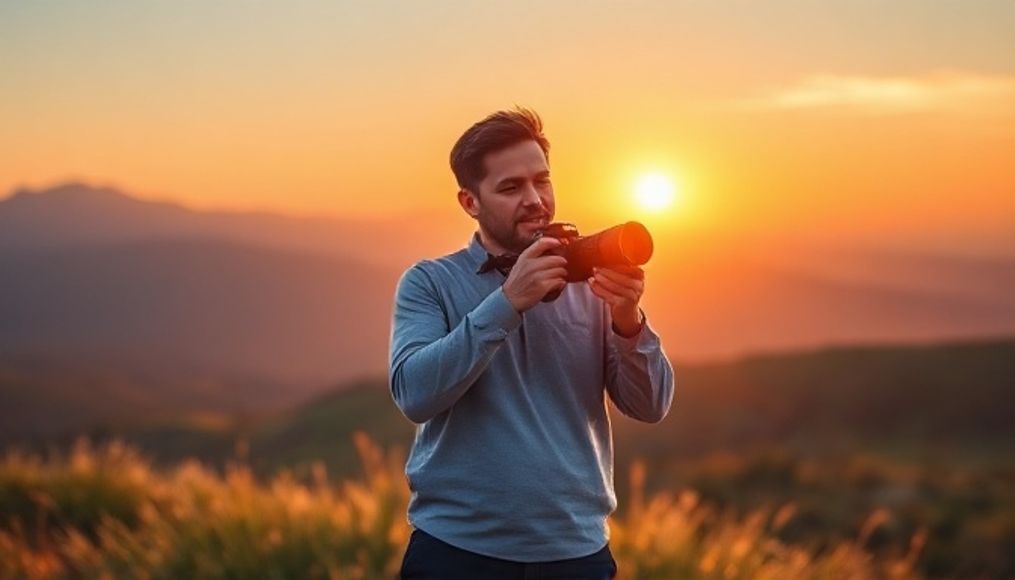Introduction: The World of Photo Editing at Your Fingertips
In our digital age, photos have become an integral part of our daily lives. Whether we're sharing moments on social media, showcasing our products online, or preserving precious memories, photos play a vital role. But have you ever wondered how we can transform an ordinary image into an attractive work of art? The answer lies in photo editing.
Fortunately, photo editing is no longer limited to professionals with complex and expensive software. Today, there are many simple and free programs that allow you to enhance your photos quickly and easily. Whether you're a complete beginner or have some experience, you'll definitely find a program that suits your needs and budget.
In this article, we'll explore the world of photo editing using simple programs, providing you with practical steps and valuable tips to achieve professional results. We'll cover the basics of editing, review some excellent free tools, and provide real-world examples to apply what you've learned.
Chapter 1: Why Should You Edit Your Photos?
You might ask, why should I waste my time editing photos? Aren't the photos I take with my smartphone enough? Well, there are several compelling reasons why photo editing is a necessary step to improve the quality of your photos and make them more appealing:
- Improve Lighting and Contrast: Often, the photos we take are not ideal in terms of lighting and contrast. The image may be too dark or too bright, or it may lack contrast between colors. Adjusting the lighting and contrast can solve these problems and make the image clearer and more vibrant.
- Correct Colors: The colors in the image may be inaccurate or faded. Adjusting the colors can restore vibrancy and make them closer to reality.
- Remove Imperfections: The image may contain unwanted imperfections, such as spots, scratches, or wrinkles. Blemish removal tools can help you get rid of these problems and make the image cleaner.
- Improve Composition: The composition of the image may be imperfect. Cropping and rotating tools can help you improve the composition and make the image more balanced and appealing.
- Add an Artistic Touch: Photo editing can add an artistic touch to your photos and make them more distinctive. You can use filters and effects to give your photos a special character.
Overall, photo editing can transform an ordinary image into an attractive work of art that catches the eye and inspires admiration.
Chapter 2: Basics of Photo Editing
Before we start exploring programs and tools, let's learn some basics you should know about photo editing:
1. Exposure
Exposure refers to the amount of light in the image. The image can be overexposed if it is too bright, or underexposed if it is too dark. You should strive for a perfect balance between light and dark in the image.
2. Contrast
Contrast refers to the difference between the brightest and darkest parts of the image. The image can be high contrast if the bright parts are very bright and the dark parts are very dark, or low contrast if the bright and dark parts are close in brightness. Adjusting the contrast can make the image clearer and more vibrant.
3. Saturation
Saturation refers to the intensity of the colors in the image. The image can be highly saturated if the colors are too vibrant, or low saturation if the colors are too faded. Adjusting the saturation can restore vibrancy to the colors and make them closer to reality.
4. Sharpness
Sharpness refers to the clarity of details in the image. The image can be too sharp if the details are too clear, or unsharp if the details are blurry. Adjusting the sharpness can make the image clearer and more detailed.
5. White Balance
White balance refers to the accuracy of the colors in the image. The image can have incorrect white balance if the colors are tinted blue or yellow. Adjusting the white balance can restore the colors to their natural state.
Chapter 3: Best Free Photo Editing Programs
Now, let's review some of the best free photo editing programs you can use to enhance your photos:
1. GIMP (GNU Image Manipulation Program)
GIMP is an open-source and very powerful program that is considered a free alternative to Photoshop. GIMP provides a wide range of tools and features that allow you to edit photos professionally. GIMP may be a bit complex for beginners, but it's worth it if you're looking for a powerful and free program.
2. Photopea
Photopea is a free online photo editor that closely resembles Photoshop. Photopea offers a large set of tools and features that allow you to edit photos in an advanced manner. Photopea is relatively easy to use and does not require installing any software on your device.
3. Pixlr Editor
Pixlr Editor is a free online photo editor that provides a wide range of tools and features that allow you to edit photos quickly and easily. Pixlr Editor is relatively easy to use and is also available as a smartphone app.
4. Fotor
Fotor is a free online photo editor that provides a wide range of tools and features that allow you to edit photos quickly and easily. Fotor is very easy to use and is also available as a smartphone app.
5. Canva
Canva is a free online graphic design program that provides a wide range of tools and features that allow you to edit photos and create attractive designs. Canva is very easy to use and is also available as a smartphone app.
Chapter 4: Practical Steps to Edit Photos
Now, let's move on to the practical side and review practical steps to edit photos using a simple program like Pixlr Editor:
- Open the image in Pixlr Editor: Start by opening the image you want to edit in Pixlr Editor.
- Adjust Lighting and Contrast: Use the lighting and contrast tools to adjust the overall lighting of the image and make it clearer and more vibrant.
- Correct Colors: Use the color tools to correct the colors in the image and make them closer to reality.
- Remove Imperfections: Use the blemish removal tools to remove any unwanted spots, scratches, or wrinkles in the image.
- Improve Composition: Use the cropping and rotating tools to improve the composition of the image and make it more balanced and appealing.
- Add an Artistic Touch (Optional): Use filters and effects to give the image a special character.
- Save the Image: Save the image after you have finished editing.
Chapter 5: Tips for Achieving Professional Results
Here are some additional tips that can help you achieve professional results when editing photos:
- Don't Overdo the Editing: Avoid over-editing, as this can distort the image and make it look unnatural.
- Focus on Details: Pay attention to the small details in the image, as they can have a big impact on the overall quality of the image.
- Use the Right Tools: Choose the right tools for each task, as each tool may have a different effect on the image.
- Experiment and Learn: Don't be afraid to experiment and learn, the more you practice photo editing, the better you will become.
- Seek Inspiration: Seek inspiration in the works of professional photographers, and try to imitate their editing styles.
Chapter 6: Editing Product Photos to Increase Sales
If you sell products online, editing product photos is essential to increase sales. Here are some tips for editing product photos:
- Use a Clean Background: Use a white or light-colored background to highlight the product.
- Adjust Lighting and Contrast: Make sure the product is well lit and the colors are accurate.
- Remove Any Imperfections: Remove any spots, scratches, or dust on the product.
- Crop the Image Appropriately: Make sure the product fills the frame and the composition is appealing.
- Add a Watermark (Optional): Add a watermark to protect your photos from theft.
Chapter 7: Editing Travel Photos to Relive Memories
Editing travel photos can help you relive your precious memories and make them more vibrant. Here are some tips for editing travel photos:
- Focus on Colors: Use the color tools to enhance the vibrant colors in landscapes and buildings.
- Add Some Drama: Use filters and effects to add some drama to the photos.
- Tell a Story: Use editing to highlight the elements that tell the story of your trip.
- Don't Forget the People: Make sure the photos of people are well lit and the colors are accurate.
Chapter 8: Practical Examples of Photo Editing
Let's take a look at some practical examples of photo editing using a simple program like Pixlr Editor:
Example 1: Improving a Portrait
Suppose you have a portrait that is dark and faded. You can use Pixlr Editor to adjust the lighting and contrast, correct the colors, remove any imperfections, and improve the composition. The result will be a clearer, more vibrant, and appealing portrait.
Example 2: Improving a Product Photo
Suppose you have a product photo with a dirty background and poor lighting. You can use Pixlr Editor to remove the background, adjust the lighting and contrast, remove any imperfections, and crop the image appropriately. The result will be a professional product photo that attracts customers and increases sales.
Example 3: Improving a Travel Photo
Suppose you have a travel photo with a beautiful landscape but the colors are faded. You can use Pixlr Editor to enhance the colors, add some drama, and highlight the elements that tell the story of your trip. The result will be a vibrant travel photo that makes you remember your trip in every detail.
Conclusion: Go Ahead and Edit Your Photos!
Photo editing is not as difficult as you might think. Using simple and free programs, you can enhance your photos and make them more appealing. Remember that practice is key, the more you practice photo editing, the better you will become. Go ahead now and try editing your photos, and you will be amazed at the results you can achieve!




